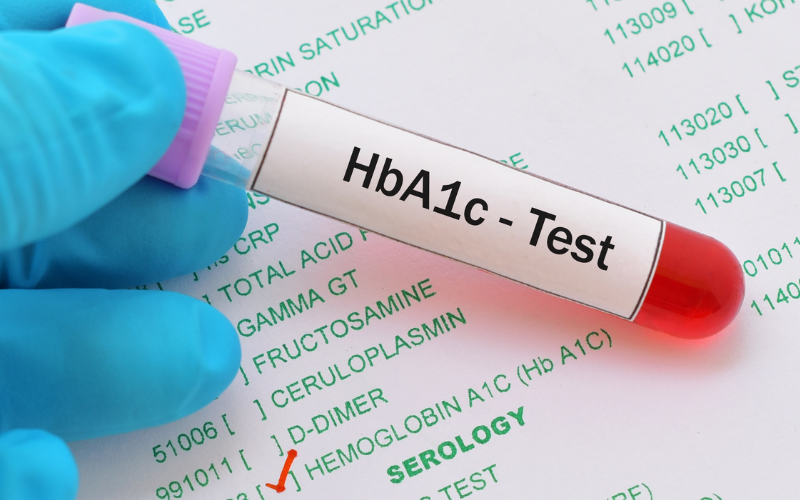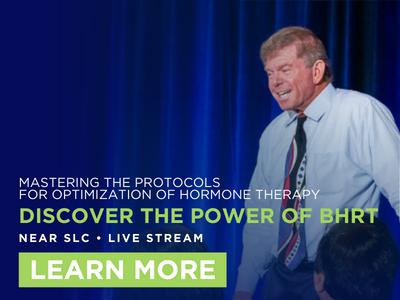
Controlling HgBA1C with Medications Does not Make Diabetes Disappear – It Lowers the Surrogate Marker HgBA1C

Written By Neal Rouzier, MD
My goal and intent of Hormones and Beyond 2021 was to introduce new and different concepts of insulin resistance and how it pertains to the development of CVD and cancer. Although the pathophysiology is simple, the treatment and reversal of the disease is what is so confusing, complex, misunderstood, and ignored. Unfortunately, due to politics and economics, the cardiovascular world along with the pharmaceutical world, has misled us to believe that the simple and easy treatment for CVD is cholesterol-centric, period. The endocrine world has misled us to believe that the simple treatment of Type 2 DM is pharmacologic driven, and this has been evidenced by lowering the HgBA1C with diabetic medications. Pure and simple. Despite the enthusiasm of the foregoing, outcome studies for CVD benefit with tight BS control are disappointing. In addition, the increase in the incidence of IR and DM has resulted in an increase in cancer. Despite aggressive cholesterol lowering with various medications, studies show that diabetic patients still demonstrate a fourfold greater risk of CVD and mortality than non-diabetics. Why have cholesterol lowering medications failed to reduce the CVD risk in diabetic patients? More so, we continue to chase surrogate numbers and ignore the increase in CVD mortality in outcome studies demonstrating the harm of tighter blood sugar control with diabetic medicines. And we continue to be misled by medical academies and guidelines thinking and believing that our goal should be to simply lower HgBA1C with medications and that will protect against CVD. Well, it didn’t, and it doesn’t, but we choose to ignore that because it doesn’t make sense to us that lowering HgBA1C with medications would not improve CVD outcomes long-term. See studies below.
Table of Contents
JAMA & NEJM
In a prior year (2020) I presented long-term outcome studies published in JAMA and the NEJM demonstrating increased CVD and poor outcomes with tighter BS control with medications. Why is this? Lowering the surrogate HgBA1C did not reduce CVD morbidity and mortality as would be expected. In fact, it made it worse. Cramming glucose into the cell where it becomes stored as fat, and increases inflammation, is not conducive to improved outcomes. (See the attachments to the first newsletter). Therefore, the focus should not be on just lowering the HgBA1C per se, but on how we lower it. Should we lower it with medications that store glucose in fat cells and organs, which then increase visceral fat, inflammation, and weight, as well as cause beta-cell dysfunction in the pancreas, and worsen CVD outcomes? Or should we lower it with medications that can burn glucose, reduce fat storage, reduce body weight and visceral fat, decrease inflammation, restore beta-cell function, reverse diabetes, cure diabetes, decrease CAC, and consistently improve CVD outcomes? (Keep in mind that lowering HgBA1C does not cure diabetes but only controls it if you are on diabetic medicines. The medicines I’m referring to cure diabetes by eliminating the need to take diabetic meds because the diabetes no longer exists. We must understand this concept. Controlling HgBA1C with medications does not make the diabetes disappear. It just lowers the surrogate marker HgBA1C). Doesn’t anyone see the elephant in the room? Why can’t you see the elephant and why do you ignore all the medical literature that proves we can prevent, reverse, and cure diabetes as opposed to controlling it? Politics and economics?
I’ve shown that which we commonly do is not working. Contrarily, I will present studies demonstrating what has been proven to work, not only in surrogate numbers, but in outcome studies which should be our ultimate goal as surrogate numbers are meaningless if they don’t correlate with improved outcome studies. However, and unfortunately, this is what we commonly don’t do because it is beyond our scope of practice or we are unaware of the data and studies. I plan to show what we commonly do is making CVD and cancer incidence worse. I plan to show what we should be doing, based on medical literature and science, but what we are not doing. Look, now there are even more elephants in the room. Don’t you see them? Is it because you don’t see them or is it that you just ignore them? Don’t reject the science and literature as that is not scientific. And stop saying that it is beyond your scope of practice.
Measuring what matters in diabetes and the fallacy of the surrogate (JAMA): HgBA1C level is a surrogate marker for a proxy of uncontrolled disease. However, lowering this surrogate did not demonstrate improvements in outcomes of stroke, CVD, and mortality. HgBA1C is a valuable forewarning indicator of future events and a monitoring tool. However, the importance of glycemic control for type 2 diabetics cannot be extrapolated from data of type 1 diabetes. Improved outcomes for type 2 DM are not demonstrated as with type 1 DM by monitoring and lowering HgBA1C. Updated national statistics indicate increase in MI and CVD mortality in young and middle-aged adults whose diabetes is controlled with diabetic medication. Obviously, all these patients are also on cholesterol lowering medications due to their inherent risk, but it has not improved CVD outcomes despite our cholesterol-centric focus on prevention. Again, why? If CVD mortality is not improved in diabetic patients on statin therapy, and statins increase the risk of IR and DM, and tight BS control with standard diabetic medications and insulin worsen CVD outcomes, then why do we continue to do what we do? Why do we continue to utilize medicines that worsen IR or store glucose as fat? What is it that we’re missing here? If aggressive cholesterol lowering and tighter control of BS are not working to decrease mortality and CVD in diabetics, why isn’t it working and what else can we do? And what about all that data and literature as to what does work to reduce CVD and mortality and improve outcomes? And why do we ignore it?
JAMA: “Moreover, HgBA1C level may be misleading and its singular prioritization could lead to patient harm.” Really? GLP-1 receptor agonists and SGLT-2 inhibitors reduce CVD events independent of glycemic control. Because they don’t store glucose as fat, rather they metabolize it and excrete it resulting in weight loss, not fat deposition. The JAMA authors state that we should rely on outcome studies rather than on surrogate markers. “Consideration should be given to reverse the routine use of surrogate markers and refocus on outcomes that are important like CVD.” (Hallelujah!)
NEJM: “In randomized trials, intensive glycemic control has not resulted in lower risks of major cardiovascular events or death than standard glycemic control. At trial completion, there was no significant difference in CVD events, mortality, or all-cause mortality. Consistent with these findings, follow-up in two major trials of intensive as compared with standard glycemic control in patients with advanced diabetes, also showed no evidence of emergent cardiovascular benefits.” “Thus, for patients with diabetes, clinical focus on how glucose levels are lowered rather than on achieving intensive targets may lead to better CVD outcomes.” Bingo! Again, this is the elephant in the room that everyone misses. We are so focused on lowering the surrogate HgBA1C and maintaining tight BS control and don’t realize the potential harm of the tight BS control with diabetes medicines. We also fail to appreciate, and choose to ignore, the increase in BS and diabetes with statin medication, relying on instead the old adage of the benefits outweigh the risks. Nevertheless, there are so many other ways to lower blood sugar and not store it in cells as fat that result in weight gain. Why not metabolize it in muscle cells and decrease weight and fat as seen in outcome studies with testosterone, estradiol, and T3?
NEJM: “There was no evidence of a legacy effect (long-term benefit) or a mortality benefit with intensive glucose control.” Why not? Isn’t that what we should expect? It is because we are cramming glucose inside the cell where it is stored as fat thereby increasing weight, visceral fat, inflammation, inflammatory cytokines, and apo-B. And statins antagonize this affect by increasing BS, dyslipidemia, and BMI. Should we not be utilizing medicines that reverse diabetes and dyslipidemia, decrease glucose and fat storage, reduce inflammation, decrease weight and visceral fat, and that have a legacy effect by decreasing CVD morbidity and mortality in outcome studies? Why, yes, of course. The medical literature and studies support the use of hormones to decrease CVD, diabetes, reverse atherosclerosis, and improve QOL.
NEJM: “In conclusion, in this group of participants with type 2 diabetes who were at high risk for CVD, 5.6 years of intensive glucose lowering to a glycated hemoglobin level of 6.9% did not reduce the incidence of major CVD events over a follow-up of 13 years or reduce total mortality or improve QOL over 15 years.” And because they were “high risk for CVD,” I’m sure that they were on maximum statin therapy also. I’ll review all the RCTs whereby testosterone resulted in 100% decrease in CVD events as well as mortality. E2 also reduces morbidity and mortality from CVD and reduces diabetes, CAC, plaque, dyslipidemia and improves QOL as opposed to the NEJM study. And if HRT reduces BS and diabetes, what effect will that have on cancer? As opposed to all the drugs we prescribe that increase IR and DM and the risk of cancer?
Stay Tuned for more on what I will cover in Hormones and Beyond 2022,
Neal
If you are interested in learning more about the value and efficacy of BHRT as an alternative to medication-based therapies, please consider our four part Hormone Optimization Workshop Series, and start training with us at Part I: Discover the Power of BHRT.
